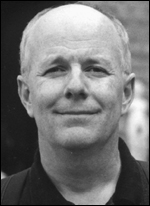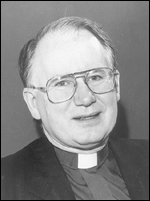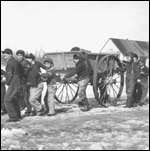Note for U.S. readers: While the term “Indian” is understood in Canada, the country's native people are more commonly called “aboriginals” or “First Nations,” the usages generally employed in this article.
Canada’s now-defunct residential school system has left a disastrous legacy for many aboriginal people. Torn from their parents, languages, and culture, many received a poor education, lived in squalid conditions, and were physically and sexually abused. For 150 years, the schools, largely run by churches, were paid for and overseen by the Canadian government. Those groups are now paying for their roles in the school system, forced to defend themselves in lawsuits launched by thousands of aboriginals demanding restitution for what they, or their parents, suffered.
Indeed, Canada’s three largest churches face so many civil suits that they are talking, to various degrees, of declaring bankruptcy. The federal government is making it even tougher, dragging them into lawsuits in which the plaintiffs did not name them. Ottawa is countersuing the churches as third parties and, in a few cases, even naming aboriginal parent advisory committees in their cross claims. Church officials speculate that the Canadian government does not want to be left alone to face the wrath of aboriginals but wishes to spread the blame around.
 |
| Gerry Kelly is the adviser on aboriginal issues for the Canadian Conference of Catholic Bishops. |
Both the Anglican Church and the United Church of Canada have warned of possible national bankruptcy. The Anglicans also have two dioceses in deep trouble—Cariboo, whose see city is Kamloops, British Columbia, and Qu’Appelle, based in Regina, Saskatchewan. Several Roman Catholic orders and dioceses are also reported in precarious straits. “The Whitehorse [Yukon] diocese in the Catholic Church is operating now day to day and facing a number of more lawsuits. Likely they won’t even be able to sustain the cost of defending,” said Gerry Kelly, the aboriginal issues adviser to the Canadian Conference of Catholic Bishops. “Some dioceses will go bankrupt.” Some religious orders are “quite likely to go bankrupt and disappear,” he added.
As many as 6,000 aboriginals are listed in claims against the government. Many claims also name the three churches and, to a much lesser extent, the Presbyterian Church, which ran just three of the 100-odd schools.
Whose fault?
Many hold that the federal government bears primary responsibility for residential schools. The final report from the Royal Commission on Aboriginal Peoples, released in November 1996, paints a horrific picture of the school system. (See “What the Royal Commission Found” at the end of this article.)
After the Second World War, the government began to phase out residential schools, believing its key goal of assimilation would be achieved more easily if aboriginals attended provincially run schools with white children. It would also cost the government much less. In 1969, the government formally took over the residential schools from the churches; all school employees became civil servants.
Today, the churches contend they carried out government policy and hold Ottawa responsible for the bulk of financial reparations. “In issues of [physical or sexual] abuse, there may be some dispute as to whether there are issues of negligence on the behalf of a church organization,” Kelly said. “A policy’s a policy, and the policy doesn’t belong to the churches. However, the government doesn’t seem willing to concede that.” The Reverend Brian Thorpe, newly appointed spokesman for residential schools for the United Church, agreed. “The churches really, in terms of the day-to-day operation of the schools, had very little influence,” he said. “The government paid the bills and ran them. It’s difficult to say that without sounding like you’re evading your responsibilities.”
 |
|
Professor Jim Miller of the University of Saskatchewan’s history department is the author of Shingwauk’s Vision, the first in-depth study of residential schools in Canada.
|
The churches walk a fine line, trying to support and stand by aboriginals in their search for justice, while defending themselves in court. Professor Jim Miller of the University of Saskatchewan’s history department agrees the Canadian government ought to bear the most responsibility. Miller authored the first in-depth study of residential schools in Canada, Shingwauk’s Vision, a book ten years in the making. For years the government minimized its role in the residential schools policy, ignoring pleas by aboriginals to apologize and make reparations, he said. In January 1998 the government finally issued a formal apology and set up a $350 million “healing fund.”
In earlier years, Miller said, the government found it cheaper to delay through litigation than to settle claims. One court tactic was to move to include churches as correspondents in the cases. “The government was unhelpful, much preferring to make the churches the scapegoat,” explained Miller. “It was very easy to pin the rap on the churches. Not many people cared about the churches anymore.”
The first court decision against the Anglican Church involved St. George’s Residential School in Lytton, British Columbia. The ruling found the church’s national body and the Diocese of Cariboo jointly 60 percent responsible for the plaintiff’s abuse, the government 40 percent. The church, appealing its share, contends that the general synod had nothing to do with the school. The case involves a child-care supervisor who sexually assaulted a series of boys two to three times each week over eight years, beginning in 1965. Derek Clarke—fired from his previous child-care job as unqualified—would often choose a boy for the evening after he lined them up naked for “inspection” after a shower, testimony disclosed. The judge’s decision last August found that the principal likely turned a blind eye because he, too, was abusing boys. By the time the civil suits began, Clarke had been convicted and imprisoned.
“I think those proportions are inappropriate,” Miller said of the sixty-forty split. “The government has constitutional responsibility for Indians [and] had the responsibility to inspect and ensure its charges were properly being served. They had a fiduciary responsibility to the aboriginals. They did not discharge it. That doesn’t let the churches off the hook. But for political, financial, and other reasons, the government should bear the lion’s share. The people of Canada, the government of Canada, were responsible for the policy.”
What were they thinking?
Historically, the government used residential schools to assimilate aboriginals into the rest of Canadian society. According to Miller, the government, the churches, and aboriginals themselves all had different interests in a comprehensive schooling system. “The government’s objective was primarily to educate and train aboriginals so they would become economically self-sufficient.”
 |
| The Reverend Brian Thorpe is residential schools coordinator of the United Church. |
The churches had two objectives: to convert aboriginals to Christianity and to help their communities become self-sufficient in an economy that could no longer depend on the nearly extinct buffalo. Finally, aboriginals saw the need for education and were willing to adopt Euro-Canadian schooling though they didn’t necessarily want residential schooling. What they got was assimilation, denigration of their culture, and all the rest.
Residential schools operated from the mid-nineteenth century until the early 1980s. Reports surfaced periodically about poor schooling and abysmal conditions. An apathetic Canadian public raised no fuss; the government continued to underfund the system and ignore the problems. Cash-strapped schools continued to employ some poorly trained and abusive staff members, although many were dedicated and caring, doing their best under trying conditions.
Until reports of grotesque sexual abuse began emerging in the late 1980s, Canadians were mostly unaware of the problems. By the early 1990s, the churches had apologized for their role in the system and set up “healing funds” aboriginals could dip into; the government failed to follow suit until January 1998. Many aboriginals likely wouldn’t have gone to court if the churches and government had offered to make reparations earlier, Miller said. Now early successes and aggressive lawyers are encouraging them to sue.
What lies ahead?
Claims in which sexual abuse has already been criminally proven are being settled out of court. The government has paid more than 200 claims, the churches about forty among them. Confidential settlement terms are estimated between $20,000 to $200,000 per case, but that’s just a fraction of what’s to come. Another 6,000 or so plaintiffs await.
The wild card yet to be tested in court is “cultural genocide.” For example, a class-action claim by about 1,000 Mohawks in Ontario demands $1 billion for former students and their families for such intangibles as loss of culture. No one knows what value a court might set.
Financial consequences depend partly on a church’s structure. The Roman Catholic Church, a community of dioceses, has no national entity. Various dioceses and orders ran the schools and are defending themselves individually. The United Church, conversely, ran its schools nationally. It has yet to be tested in court whether congregational properties are at risk of being sold to pay damages. Although bankruptcy has been discussed, a recent bequest of $20 million is expected to forestall any immediate problems.
The Anglican Church’s Missionary Society of the Church in Canada was involved in many of the schools, as were individual dioceses. The national church’s only property is its head office building in Toronto, valued around $3 million. An estimated $7 million in reserves is available for legal costs and settlements, then bankruptcy looms. The churches’ insurance is limited to the coverage in effect at the time of the alleged offenses. It’s only a fraction of what is being sued for.
Theological schools in Canada seem safe from direct claims, since they are run as independent corporations. The vulnerability of a few seminaries run by Roman Catholic religious orders has yet to be tested in court. Schools associated with the United Church may feel the pinch of lower grants but haven’t yet, Thorpe said. The Anglican Church does not give grants to theological schools, says Archdeacon Jim Boyles, general secretary of the church’s general synod and spokesman for residential schools.
Not all the action is in the courts. A couple years ago, the government suggested pilot projects using “alternative dispute resolution.” The churches say they like the idea because it allows a more pastoral approach. They don’t, however, expect it to be less costly. Each ADR project is to involve the government, a church, and about fifty aboriginals. The pilots have been painfully slow in starting. Two have begun; another seven are in the works. The government and the churches continue to negotiate who will pay what.
Meanwhile, the churches are unhappy that the government continues to drag them into lawsuits where they were not originally named. For example, of the seven cases concerning St. George’s School that were to come to court at the end of March, only one plaintiff initially named the church, Boyles said. The government named the church as a third party in the other six. “At the same time as they are seeking our cooperation [with ADR], they are playing hardball with us in the courts,” he said.
Ottawa has been very aggressive, agreed Kelly. “The federal government seems intent not only in terms of identifying Catholic organizations but identifying multiple Catholic organizations.” In one case twenty different Catholic organizations were third-partied.
To ensure their survival, the churches have tried to get the government to agree to cap the total dollar amounts they must pay. Thorpe is not optimistic. “It’s going to be a tough road in a post-Christendom era. The real question is how much does the government invest in ensuring the churches survive.”
The churches, having negotiated primarily with bureaucrats, are now trying to get elected officials involved, targeting members of Parliament sympathetic to or involved in religious groups. The Anglican Church plans to hire an Ottawa lobbying firm.
 |
| Bill Blaikie, member of Parliament for the Winnipeg Transcona riding, is a member of the left-leaning New Democratic Party. |
Opposition MP Bill Blaikie (also a United Church minister) was the first to respond. In the House of Commons on March 17, Blaikie called on the government to be more willing to share the cost with the churches. “Surely it is important to make sure that the churches involved do not go bankrupt or are so severely economically damaged that much of their social service and social action work will have to be eliminated just to survive,” he said. “It is also important that justice be accomplished swiftly for those who have legitimate claims. This cannot be done if this issue drags on for years, claim by claim.”
Blaikie said he hasn’t been approached by constituents on the issue, but parishioners have expressed concerns. He doesn’t believe the general public is aware yet of how serious the financial impact of lawsuits could be on the churches. That same week, the Law Commission of Canada released a lengthy report on child abuse in Canadian institutions, including native residential schools. It called on the federal government to compensate aboriginals and negotiate with the churches and victims on a redress program.
Many natives have no interest in suing the churches, said lawyer Tony Merchant, whose Saskatchewan firm, the Merchant Law Group, represents about half the aboriginal plaintiffs. “Very few are resentful towards the churches,” he said. “This is not ‘get even,’ it’s bring it to an end. So we don’t sue the churches. We just sue the government.” Merchant charges 30 percent on contingency. Some firms reportedly charge less.
What’s the hold up?
The government is now also cross claiming against First Nations groups, contending that their advisory boards—set up under the government’s direction—should have known what was going on. Merchant accused government lawyers of going out of their way to delay settlements. “There’s a number of reasons for delay. One, we’ve had sixteen people die. They get nothing. Two, the standard insurance company reason for delay is that people then get sick of it, and you can get them to settle for less money. The next financial motive is why pay now when we can pay in a year . . . or in three years?” Delays also cause many law firms to avoid taking such cases because they aren’t financially lucrative enough, he contended.
 |
| Shawn Tupper is a residential schools spokesman with the Federal Department of Indian Affairs. |
“That’s blatantly untrue,” responded Shawn Tupper, residential schools spokesman for the Federal Department of Indian Affairs. The government offers settlements in appropriate cases, but “we need to validate the claims, not just issue checks.” Ottawa’s third-party claims are to deal with all the variables—time frames, which staff members are accused, and so on. “We are of the view that there are periods of time the churches bear partial responsibility,” he said. “We want you at the table to deal with what you’re responsible for.”
That also applies to naming First Nations groups when, in later years, their parent advisory committees bore partial responsibility for the schools. They may share responsibility for some employees, Tupper said. “It depends on who’s been identified by the plaintiffs. They may name a bunch of people—cooks, teachers, administrators. You end up with a variety of organizations involved.” The government knows First Nations groups don’t have a lot of money for settlements, but it wants to present to the court the clearest view of what went on. At the same time, it is trying to get the documents in advance and get early discussions going to minimize costs, he said.
Merchant also answered charges that lawyers are behaving like ambulance-chasers, encouraging natives to sue who wouldn’t otherwise consider it. “Here we have 100,000-plus people who went through the residential schools to whom serious wrongdoing was done in many, many instances, and they believe they can’t sue. So if lawyers have communicated to them that they can sue, well, I say, those lawyers should be congratulated.”
The courts, attempting to cope with huge numbers of lawsuits, are “fast-tracking” eight representative cases in Saskatchewan this spring to set precedents.
 |
|
Archdeacon Jim Boyles is the general secretary of the Anglican Church.
|
The challenge to churches is to protect against bankruptcy so they can continue their work, while standing beside their native brethren. Aboriginals often are members of the churches being sued. At the same time, the churches must explain to non-native members why they must pay out vast sums to right wrongs committed in bygone years when attitudes were different. Canada’s general public has just begun to hear reports in secular media of the churches’ financial predicament. Some church members are asking how they might contribute to a fund for people affected by the schools; others question why the churches are liable for anything. The Anglican bishop of Qu’Appelle raised fears of a racist backlash against aboriginals in a pastoral letter to parishes last fall.
Native peoples are not united in their response to the residential schools legacy. A number have said publicly they don’t believe lawsuits do anything to heal the wounds. A few have said they received a good education at the schools. At a meeting of the Anglican Church’s governing body last year, an aboriginal Anglican priest tried to explain the growing litigation: “You took away our sundances, our potlatches, our spirituality. Our people are now more individualistic, less mindful of their brothers and sisters. The result is litigation.”
 |
|
Tony Merchant is a lawyer whose Saskatchewan firm represents about half the residential school claims in Canada.
|
Despite gloomy economic forecasts, many in the churches are finding reason for optimism. Let us go bankrupt and start anew in the third millennium, some suggest. The church’s mission does not depend on its buildings, others say. After receiving the first notice of legal action relating to a residential school in his diocese, Caleb Lawrence, the Anglican bishop of Moosonee in northern Ontario, wrote to his diocese: “In many ways, despite the strain and worry over possible crippling lawsuits, this may be one of the most challenging and exciting periods in the history of the church in Canada, opening opportunities for healing, reconciliation and inclusivity which will bring us closer to Christ and to one another.”
What the Royal Commission Found
The Royal Commission on Aboriginal Peoples was established in 1991, staffed by four aboriginal and three nonaboriginal commissioners. They held 178 days of public hearings, visited ninety-six communities, and commissioned research. The commission issued its final report in 1996.
The schools never produced well-educated graduates, it says. In fact, most students didn’t even graduate. Of 9,149 residential school students in 1945, only slightly more than 100 students were enrolled above grade 8, with no record of any students beyond grade 9.
In 1968 R. F. Davey, director of educational services, conducted a review of the educational performance of the system up to 1950. He reported that the practical training in place “contained very little of instructional value but consisted mainly of the performance of repetitive, routine chores of little or no educational value.” As late as 1950, “over 40 per cent of the teaching staff had no professional training.” Some had not even graduated from high school.
The schools were always underfunded. Government figures showed a per capita rate of $180 in 1938—much lower than other residential care facilities (two for the deaf in Manitoba received $550 and $642). Funding for similar U.S. institutions ranged from $313 to $541.
 |
| Hard work in brutal conditions was the lot of many students at residential schools such as this one—the Bishop Horden Memorial School in Moose Factory, Ontario, which opened in 1918.
The Anglican Church of Canada Archives
|
Churches took as many students as possible to earn more grant money. Inadequate facilities and overcrowding contributed to the spread of tuberculosis and other diseases. A 1907 survey of 15 schools put the death toll of children at 24 percent. “The rate varied from school to school going as high as 47 per cent at Old Sun’s on the Blackfoot reserve,” the report said.
Scores of children ran away from the schools despite potential punishment. Two tragedies in British Columbia are described: “In 1902, Johnny Sticks found his son, Duncan, dead of exposure, having fled from the Williams Lake industrial school.” Four boys who ran away from the Lejac school in 1937 were found “frozen to death on the lake within sight of their community. They were wearing only summer-weight clothes.” Staff, children and graduates testified to a history of neglect and violence.
The government failed to set standards: “Comprehensive regulations on the acceptable means and limits to punishments were never issued, despite requests by more junior departmental employees, and thus principals and staff behaved largely as they saw fit. Children were frequently beaten severely with whips, rods and fists, chained and shackled, bound hand and foot and locked in closets, basements, and bathrooms, and had their heads shaved or hair closely cropped.”
Inspector W. Graham brought a number of incidents to the government in the early 1900s. Each time Ottawa asked for explanations, but the offenders were never fired. Graham told of a boy beaten “black from his neck to his buttocks” at the Anglican MacKay school in Manitoba in 1924. The principal, a priest, admitted marking the boy, but the matter dropped. The next year another boy fled from the school “almost naked and barefoot.” He was found after a week in the bush “nearly out of his mind” from being “whaled black and blue.” The principal was exonerated again. At the time, the report notes, the “church was a force to be reckoned with in the national political arena and therefore in the school system.”
For many the legacy of residential school continues. “Persons who attended these schools continue to struggle with their identity after years of being taught to hate themselves and their culture,” stated consultants for the Assembly of First Nations. “The residential school led to a disruption in the transference of parenting skills from one generation to the next. Without these skills, many survivors have had difficulty in raising their own children.” Learning that adults often exert power and control through abuse, many survivors of the system inflict abuse on their own children.
Also of interest: "Right Place, Right Time" (Spring 2002)